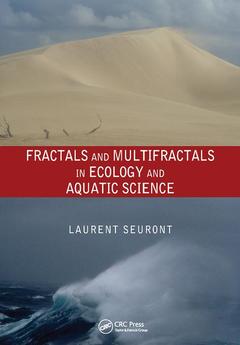Fractals and Multifractals in Ecology and Aquatic Science
Auteur : Seuront Laurent

Ecologists sometimes have a less-than-rigorous background in quantitative methods, yet research within this broad field is becoming increasingly mathematical. Written in a step-by-step fashion, Fractals and Multifractals in Ecology and Aquatic Science provides scientists with a basic understanding of fractals and multifractals and the techniques for utilizing them when analyzing ecological phenomenon.
With illustrations, tables, and graphs on virtually every page ? several in color ? this book is a comprehensive source of state-of-the-art ecological scaling and multiscaling methods at temporal and spatial scales, respectfully ranging from seconds to months and from millimeters to thousands of kilometers. It illustrates most of the data analysis techniques with real case studies often based on original findings. It also incorporates descriptions of current and new numerical techniques to analyze and deepen understanding of ecological situations and their solutions.
Includes a Wealth of Applications and Examples
This book also includes nonlinear analysis techniques and the application of concepts from chaos theory to problems of spatial and temporal patterns in ecological systems. Unlike other books on the subject, Fractals and Multifractals in Ecology and Aquatic Science is readily accessible to researchers in a variety of fields, such as microbiology, biology, ecology, hydrology, geology, oceanography, social sciences, and finance, regardless of their mathematical backgrounds. This volume demystifies the mathematical methods, many of which are often regarded as too complex, and allows the reader to access new and promising concepts, procedures, and related results.
About Geometries and Dimensions. Self-Similar Fractals. Self-Affine Fractals. Frequency Distribution Dimensions. Fractal-Related Concepts: Some Clarifications. Estimating Dimensions with Confidence. From Fractals to Multifractals.
Laurent Seuront is a Professor in Biological Oceanography at the Flinders University (Adelaide, Australia) and a Senior Research Scientist at the South Australian Research and Development Institute (West Beach, Australia). Prior to his present position, he was a research fellow of the Japanese Society for the Promotion of Science at the Tokyo University of Fisheries (1999-2000) and a research scientist at the Centre National de la Recherche Scientifique (CNRS) in France (2001-2008). Among multiple awards, he recently received the CNRS Bronze Medal in France (2007) in recognition of his early career achievements, and a prestigious Australian Professorial Fellowship from the Australian Research Council.
Date de parution : 09-2017
17.8x25.4 cm
Date de parution : 10-2009
Ouvrage de 288 p.
17.8x25.4 cm
Thèmes de Fractals and Multifractals in Ecology and Aquatic Science :
Mots-clés :
Fractal Dimension; Vivo Uorescence; dimension; Eastern English Channel; sciences; Log Log Plot; phytoplankton; Fractal Dimensions Estimated; biomass; Fractal Analysis; analysis; Data Set; vivo; Embedding Dimension; uorescence; CRW; log-log; Self-organized Criticality; plot; Phytoplankton Biomass; embedding; Hurst Exponent; Fractional Gaussian Noise; Vincent Van Gogh; Turbulent Kinetic Energy Dissipation Rate; Swimming Path; Zipf’s Law; Power Law Behavior; Spectral Exponent; Burrow Morphology; Phase Space Portraits; Ood Tide; Generalized Correlation Functions; Cumulative Distribution Functions



